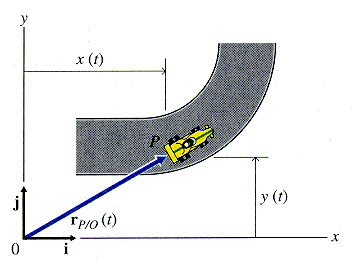Math Preliminaries (continued)
Vector
and Parametric Equations vs. Cartesian Equations
Recall from statics that we used a position vector R to locate a point P in space and wrote it, in cartesian coordinates, as follows:
![]()
|
where, x = f(t) and y = g(t) are called the parametric equations of the curve. |
 |
A cartesian path equation y = f(x) may be obtained by eliminating time t from the x = f(t) and y = g(t) parametric equations.
While it is more customary to give the equation of a curve in cartesian path form, it alone is not a description of motion—it is only a locus of (x,y) values.
Parametric
equations, on the other hand, provide
a complete description of a body’s motion, giving information such as:
(a)
Starting point,
(b)
Direction,
(c)
Rate (velocity),
(d) Domain
(the part of the path the particle moves along), and
(e) Acceleration.